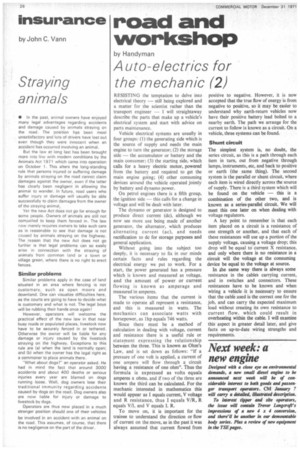road and workshop
Page 28

If you've noticed an error in this article please click here to report it so we can fix it.
by Handyman
Auto-electrics for the mechanic (2)
RESISTING the temptation to delve into electrical theory — still being explored and a matter for the scientist rather than the transport engineer — I will straightaway describe the parts that make up a vehicle's electrical system and start with advice on parts maintenance.
Vehicle electrical systems are usually in four groups: (1) the generating side which is the source of supply and needs the main engine to turn the generator; (2) the storage side — the accumulator or battery and the main consumer; (3) the starting side, which calls for a heavy electric motor, powered from the battery and required to get the main engine going; (4) other consuming devices around the vehicle operated jointly by battery and dynamo power.
On petrol engines there is a fifth group, the ignition side — this calls for a change in voltage and will be dealt with later.
The dynamo or generator is designed to produce direct current (dc), although we now see more use being made of another generator, the alternator, which produces alternating current (ac). and needs rectification to dc for storage purposes and general application.
Without going into the subject too deeply, it is necessary to fix in our minds certain facts and rules regarding the electrical energy we put to work. For a start, the power generated has a pressure which is known and measured as voltage. and the amount of power or current flowing is known as amperage and measured in amperes.
The various items that the current is made to operate all represent a resistance, and this is measured in watts. The mechanics can associate watts with horsepower, as 1hp equals 746 watts.
Since there must be a method of calculation in dealing with voltage, current and resistance there is a useful rule or statement expressing the relationship between the three. This is known as Ohm's Law, and is set down as follows: "If a pressure of one volt is applied, a current of one ampere will flow through a circuit having a resistance of one ohm". Thus the formula is expressed as volts equals amperes x ohms, and if two of the three are known the third can be calculated. For the mechanic interested in mathematics this would appear as 1 equals current, V voltage and R resistance, thus I equals V/R, R equals VI, and V equals I. R, To move on, it is important for the trainee to understand the direction or flow of current on the move, as in the past it was always assumed that current flowed from
positive to negative. However, it is now accepted that the true flow of energy is from negative to positive, so it may be easier to understand why earth-return vehicles now have their positive battery lead bolted to a nearby earth. The path we arrange for the current to follow is known as a circuit. On a vehicle, three systems can be found.
Shunt circuit
The simplest system is, no doubt, the series circuit, as this is a path through each item in turn, out from negative through lamps, instruments, etc, and back to positive or earth (the same thing). The second system is the parallel or shunt circuit, where each item is wired directly across the source of supply. There is a third system which will be found on the vehicle — this is a combination of the other two, and is known as a series-parallel circuit. We will meet this one later on when dealing with voltage regulators.
A key point to remember is that each item placed on a circuit is a resistance of one strength or another, and that each of these resistances will use up a portion of the supply voltage, causing a voltage drop; this drop will be equal t6 current X resistance, and only where there is no resistance in a circuit will the voltage at the consuming device be equal to the voltage at source.
In the same way there is always some resistance in the cables carrying current, and in switches and connectors. These resistances have to be known and when wiring a vehicle it is necessary to ensure that the cable used is the correct one for the job, and can carry the expected maximum load without creating its own resistance to current flow, which could result in overheating within the cable. I will examine this aspect in greater detail later, and give facts on up-to-date wiring strengths and requirements.












































































